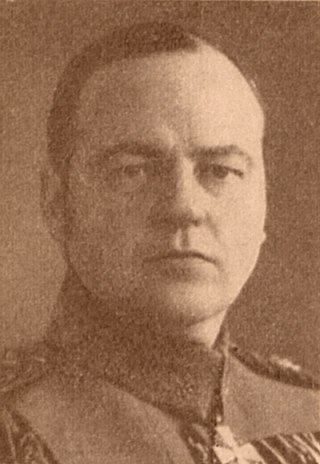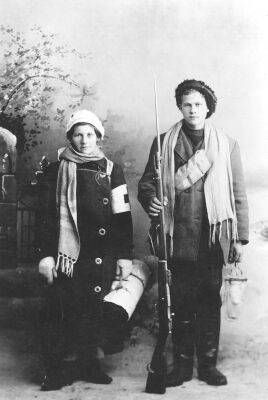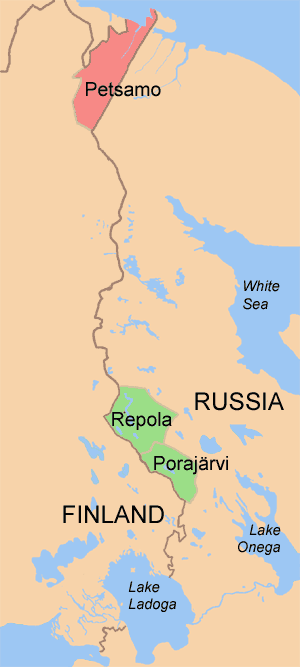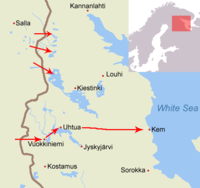
The Winter War was a war between the Soviet Union and Finland. It began with a Soviet invasion of Finland on 30 November 1939, three months after the outbreak of World War II, and ended three and a half months later with the Moscow Peace Treaty on 13 March 1940. Despite superior military strength, especially in tanks and aircraft, the Soviet Union suffered severe losses and initially made little headway. The League of Nations deemed the attack illegal and expelled the Soviet Union from its organization.
The Aunus expedition was an attempt by Finnish volunteers to occupy parts of East Karelia in 1919, during the Russian Civil War. Aunus is the Finnish name for Olonets Karelia. This expedition was one of many Finnic "kinship wars" (heimosodat) fought against forces of Soviet Russia after the Russian Revolution of 1917 and during the Russian Civil War.

Karelia is an area in Northern Europe of historical significance for Russia, Finland, and Sweden. It is currently divided between northwestern Russia and Finland.

White Karelia is a historical region in Northern Europe, comprising the northernmost part of Karelia, and the Republic of Karelia in Russia. It is bordered by the White Sea to the east, Murmansk Oblast to the north, Finland to the west, and the Muyezersky and Segezhsky Districts of the Republic of Karelia to the south.

Kurt Martti Wallenius was a Finnish Major General.
The Order of the Day of the Sword Scabbard, or the Sword Scabbard Declaration, actually refers to two related declarations by the Finnish Commander-in-Chief Carl Gustaf Emil Mannerheim during World War I and World War II against Soviet control of East Karelia.

The Red Guards were the paramilitary units of the labour movement in Finland during the early 1900s. The Red Guards formed the army of Red Finland and were one of the main belligerents of the Finnish Civil War in 1918.

Greater Finland, was an irredentist and nationalist idea that was a subset of Pan-Finnicism which emphasized the territorial expansion of Finland. The most common concept of Greater Finland saw the country as defined by natural borders encompassing the territories inhabited by Finns and Karelians, ranging from the White Sea to Lake Onega and along the Svir River and Neva River—or, more modestly, the Sestra River—to the Gulf of Finland. Some proponents also included the Torne Valley, Ingria, and Estonia.

The Finnish term Heimosodat refers to a series of armed conflicts and private military expeditions in 1918–1922 into areas of the former Russian Empire that bordered on Finland and were inhabited in large part by other Finnic peoples. The term has been translated into English as "Kindred Nations Wars", "Wars for kindred peoples", "Kinfolk wars", or "Kinship Wars," specifically referring to Finnic kinship. Finnish volunteers took part in these conflicts, either to assert Finnish control over areas inhabited by related Finnic peoples, or to help them gain independence from Soviet Russia. Many of the volunteers were inspired by the idea of "Greater Finland". Some of the conflicts were incursions from Finland, and some were local uprisings in which volunteers wanted either to help people fight for independence or to annex areas to Finland. According to Aapo Roselius, about 10,000 volunteers from Finland took part in the armed conflicts mentioned below.

The North Russia intervention, also known as the Northern Russian expedition, the Archangel campaign, and the Murman deployment, was part of the Allied intervention in the Russian Civil War after the October Revolution. The intervention brought about the involvement of foreign troops in the Russian Civil War on the side of the White movement. The movement was ultimately defeated, while the British-led Allied forces withdrew from Northern Russia after fighting a number of defensive actions against the Bolsheviks, such as the Battle of Bolshie Ozerki. The campaign lasted from March 1918, during the final months of World War I, to October 1919.

The Murmansk Legion, also known as the Finnish Legion, was a British Royal Navy organized military unit during the 1918–1919 Allied North Russia Intervention. It was composed of Finnish Red Guards who had fled after the Finnish Civil War from the White-dominated Northern Finland to Soviet Russia and of some Finns working on the Murmansk Railroad. The Legion, along with British troops, fought off the 1918 Viena expedition of Finnish White Guards and defended the Murmansk Railroad.

The Treaty of Tartu was signed on 14 October 1920 between Finland and Soviet Russia after negotiations that lasted nearly five months. The treaty confirmed the border between Finland and Soviet Russia after the Finnish Civil War and Finnish volunteer expeditions in Russian East Karelia that resulted in annexation of several Russian districts.

The Karelian people's presence can be dated back to the 7th millennium BC–6th millennium BC. The region itself is rich with fish, lakes, and minerals, and because of that throughout history changed its holder, to this day divided between the Republic of Finland and the Russian Republic.

The East Karelian Uprising and the Soviet–Finnish conflict 1921–1922 were an attempt by a group of East Karelian separatists to gain independence from the Russian Soviet Federative Socialist Republic. They were aided by a number of Finnish volunteers, starting from 6 November 1921. The conflict ended on 21 March 1922 with the Agreements between the governments of Soviet Russia and Finland about the measures of maintenance of the inviolability of the Soviet–Finnish border. The conflict is regarded in Finland as one of the heimosodat – "Kinship Wars".
Pro-independence movements in the Russian Civil War within the territory of the former Russian Empire sought the creation of independent and non-Bolshevik nation states after the October Revolution, therefore being in direct conflict with the Russian Soviet Republic which sought to conquer them. They were often supported politically or militarily by the Entente Powers. Some of them co-operated with the Russian White movement, but others were in conflict with it. Many pro-independence movements emerged after the dissolution of the Russian Empire and fought in the Russian Civil War.
Colonel Philip James Woods was an independent unionist politician in Northern Ireland, member of the Northern Ireland House of Commons. He was a colonel in the Royal Irish Rifles, seeing action on the Western Front in the First World War and in Karelia where he raised and led a local regiment during the Allied Intervention North Russia Russia. In Belfast he worked as a textile designer.
The timeline of the Winter War is a chronology of events leading up to, culminating in, and resulting from the Winter War. The war began when the Soviet Union attacked Finland on 30 November 1939 and it ended 13 March 1940.

The Finnish military administration in Eastern Karelia was an interim administrative system established in those areas of the Karelo-Finnish Soviet Socialist Republic (KFSSR) of the Soviet Union which were occupied by the Finnish army during the Continuation War. The military administration was set up on 15 July 1941 and it ended during the summer of 1944. The goal of the administration was to prepare the region for eventual annexation by Finland.

The Republic of Uhtua, also Provisional Government of Karelia, officially called the Republic of East Karelia was an unrecognized state that existed from 1919 to 1920, formed out of five volosts in the Kemsky Uyezd of the Arkhangelsk Governorate.

Iivo Ahava was a Karelian-born Finnish military officer and nationalist who supported the idea of an independent East Karelia. In the 1918 Finnish Civil War, Ahava led a Red Guard unit fighting against the Whites on their Viena expedition. During the Allied North Russia Intervention, Ahava served as a lieutenant in the British organized units of Murmansk Legion and Karelian Regiment. He was murdered in unclear circumstances in East Karelia.















